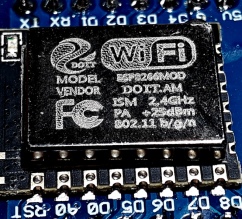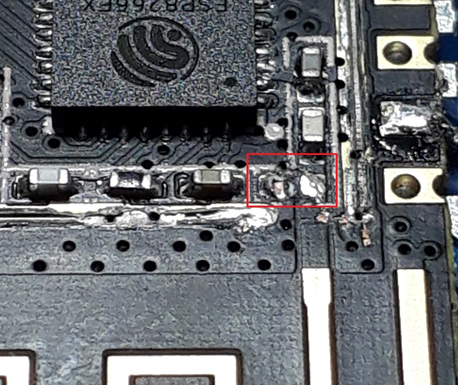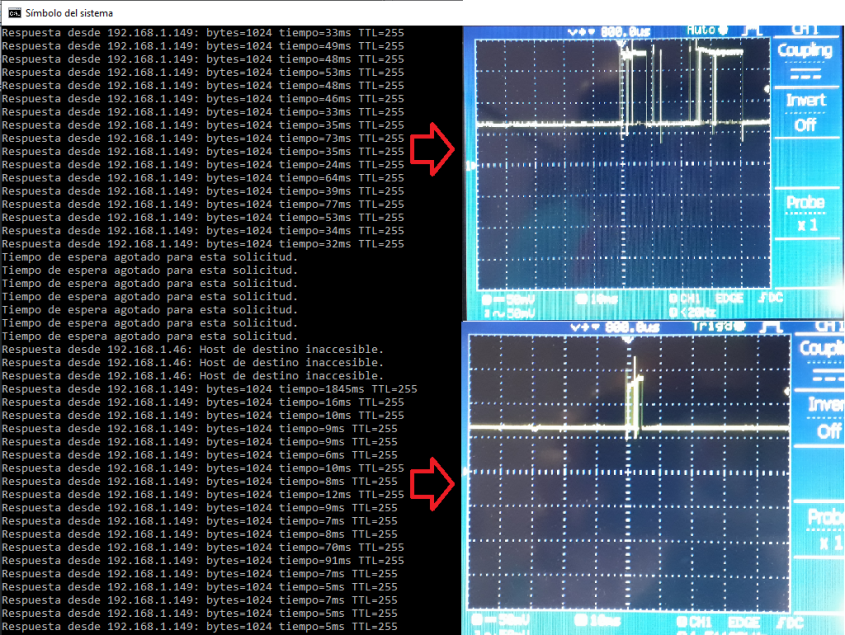I want to share my very recent experience with several Wemos D1 boards. I hope this will help someone to save time and frustration.
This is my history: A customer ask me for 50 units of very simple WiFi data logger. It’s a product I sold several times. Yes, I used the ESP8266, in a Wemos board, with a ESP12 from DOIT.AM. Plus a 5v switching power supply, two status led, two optocouplers and not much more.

When the boards arrived I observed some very strange behavior when connected to a PC by USB cable: the computer enter in a cycle of: recognize the COM port and one second after loose it, and repeat forever. The period of the cycle sometimes was very homogeneous (~0.5Hz), that should be the first thing I should pay attention, but sadly I missed it. Intermediately I changed cables, computers, but nothing. Very soon I found that if I touch the module, the cycle stopped and I can access the module normally.
I thought It could be something with the CH340, a defective chip, something with a floating pin, etc. I check everything, but not very convinced: I never like the idea of touch something to solve a electrical noise problem; it should be the opposite! But I didn’t have something better. Finally I remove the two transistors driven by the CH340 (which are used by the board to reset and to put the ESP in programming mode). Once it was programmed I won need them anymore, neither the CH340. Very dirty, but I needed to deliver the units to my customer.

That stop the ESP reboots, and seems to work for a while, but very soon I found anothers problems with the Wifi: disconnections, huge ping times, and some modules didn’t connect at all. I checked and suspected of everything. I tied to ground everything, I put filter caps everywhere, seems to help, but I didn’t get rid completely of the problem.
Of course in the middle I was trying to convince my supplier that something wasn’t right but at the same time I needed the boards as soon as possible, I knew that that kind of problems are very difficult to demonstrate (he still saying I should try another USB cable), and the worse: maybe all the boards he has on stock could have the same failure. So I was determined to solve it.
Started to remove everything from the board, eventually I have just the ESP12 board without the metallic cover

Again, improved, but still I had connection problems, and the board feels a little hot. Sadly, wasn’t so straight as I writing it, and took me 2 days (and several boards), but finally I found the culprit component: one inductor (or at least what I think it’s) capacitor in the RF output. It’s between the antenna and ground. In the picture it was already (brutally) removed. I think it should be a filter matching network which has a different value of what should be, shorting the antenna and injecting RF to GND.

After I remove it everything started to work perfect: nice ping times, no disconnections, no resets, and cold boards.
In the picture, it’s a before and after: it’s clear improvement in ping times and current consumption (0.47 ohms in series, 50 mv/div). Also it shows as fast I can open a ESP12 and remove a SMD inductor capacitor (and that explains the previous picture ;)

As soon I saw this, all pieces fit’s correctly in my mind: principally why touching something helped, and why the disconnection-connection cycle was so precise. I feel very dumb I had all the evidence: it’s was RF noise coming from the ESP, not from outside; but sadly didn’t see it clearly.
In the middle I expend time searching the web for the same symptom, but I didn’t found nothing: I can’t have so bad luck to be the only one in the world with 50 defective Wemos boards. So I hope to help someone with the same problem, or maybe to learn as not to troubleshoot.
Román

Thank you very much for this blogpost and findings.
I can think of several reported issues regarding this and I will try to remember to press your finger on the unit to see if WiFi performance improves.
If it does, then I will know where to start looking.
Any particular place to place the finger, or is touching the metal cover enough?
Hi! Yes!.. .there is a sweet spot. With the cover facing you, and the antenna upwards, you have to touch in the upper left corner of the cover. In other words just over the antenna pi matching network. Let’s see if others report the same problem and the same solution apply!
Pingback: Hackaday Links: October 13, 2019 - wiredfocus
Pingback: ESP12 — Bad batch out there | esp8266hints
Pingback: Hackaday Links: October 13, 2019 – Finance Market House
I can confirm your issues with the Do-It.am modules.
Had a bad batch of these a few months ago with identical issues.
Some other Wemos D1 clones have the same problem as well.
I spent some time thinking it had to do something with the flash chips on them because I figured that was the only real difference between those clones (aside from the LDO). Never would have guessed it could be as simple as one passive component.
With these clones it’s really hit and miss.
I have used >100 of them which are really fine for the most part but sometimes you just get a bad batch.
Even the same supplier doesn’t always send you the same ones, so you need to check and test each one before sending them out.
Although more expensive, I mostly moved on to the ‘original’ Wemos D1 Mini V3 modules sourced from Lolin/Wemos themselves. They are very consistent in quality and always have the same proper Winbond flash and the same decent LDO.
I’m not saying all clones are bad, but they take more time and care in order to ensure they work properly.
Hi Kees, thank you for sharing! When you say you can confirm, are you saying that you had the same symptoms, or did you took one of them, removed the cap ant it started to work?
Yes, you are right, clones are a lottery. But here, in Argentina, isn’t not very easy to choose. Local reselles have little idea of what are selling, and if you want to buy from outside you have to wait months. But, I learned the lesson, for my next project I’ll avoid clones!
Had the same symptoms. But I just tested it by removing the cap on a Do-It.am and now it works fine!
So good job solving this.
Thank you very much!!! you save me!!!!
Qué bueno que te sirvió! ¿Dónde los compraste? Los míos los compré en TodoMicro y me dieron como mil vueltas para cambiarlos. Cosa que no hice porque tenía que entregar el laburo; pero me encantaría poder demostrarles que vende porquería.
Got also two Wemos D1 minis (Chinese clones) with this problem, thanks to you they are now fixed.
Thank you Robert, I’m happy to help!
Hello guys. My Wemos D1 Pro brodcasts its own SSID and my code is not able to vanish that. The code compilation is error free. The same code runs perfect on NodeMCU-12E.
well, I just threw my three wemos away…
I’m observing bad WiFi on ESP-12F DOIT.AM modules these days and just wondered if anyone else has observed similar situation. Glad for this information and I’ll try your solution. My ESP-12’s from AiThinker work fine. Despite that I plan to move to WROOM-02 modules since I believe they’re sourced by Espressif and should be better quality I guess…
Hi Roman, I have another ESP8266 board from Doiting. And have problems with it. The removing of metal cover helps. I am on the way to make my first program on it! Thank you very much for this post!
Hi! Nice to know. But take in account, that in my case wasn’t just de metal cover remove, I had to remove one SMD component (a capacitor) Regards!
Hi !
Thank you very very much for your description !
I’ve just managed to “repair” 90 pieces of unstable ESP8266 D1 mini’s produced by DOITING.
The physical layout is a bit different from you pictures, but removing the right most component above the antenna, makes the ESP stable !
Hi! It makes me very happy to hear that you have been able to repair so many pieces! Thanks for letting me know!
Thanks so much for this post it is still bringing back esp’s from the dead in 2022. I had a bunch of these that were dodgy lying in my parts case because I could never get them to work right with the same symptoms you described. I just took one popped off the shield, cut off the cap and it works perfectly. Now I can finally make use of them years later.
Increíble, anduvo! Tenía el mismo problema, éste ni siquiera se conectaba a wifi, una vez removido el capacitor se conecta inmediatamente. No fue fácil encontrar este post, llevo días tratando de encontrar la raíz del problema. Muchas gracias!
It worked!, I had the same problem, it didn’t even connect to Wi-Fi, once the capacitor was removed it connected immediately. It was not easy to find this post, I have been trying to find the root of the problem for days. Thank you very much!
Agrego un dato curioso: Tengo 3 de estos dispositivos, dos de ellos presentaban el problema que se solucionó quitándoles el capacitor. El tercero, que no lo había usado demasiado, pero que no había notado que fallara, al sacarle el cobertor metálico, descubrí que no tenía el capacitor… Los tres son del mismo fabricante y modelo
I add a curious fact: I have 3 of these devices, two of them had the problem that was solved by removing the capacitor. The third, which had not been used much, but had not noticed that it failed, when I removed the metal cover, I discovered that it did not have the capacitor… All three are from the same manufacturer and model